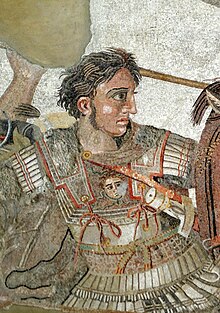Warhorse
As warhorses , well armed and battle steeds ( mhd . Kampfros, mar (c (h) , lat . Dextrarius ) mentioned, which were horse called, which until the Renaissance were ridden in combat.
properties
These horses came from the finest breeds , were well trained and expensive to buy and maintain. They had to carry the weight of a heavily armored rider, often that of their own armor , and at the same time be able to reach the necessary speed in the attack formation to ride down the opposing infantry (heavy cavalry). The most successful among them were glorified, similar to the heroes or their swords, and featured in songs such as B. sung about in the Edda . The horses had to be trained and educated constantly (see equestrian art ). If wars or tournaments were imminent, they were spared and carried alongside - at that time more comfortable gaited horses , so-called tenters or tölter, were preferred for traveling - and only ridden for actual use.
Appearance of warhorses
The war horses of antiquity were all relatively small horse types, comparable to today's Camargue horses . In Central Europe, horse breeding of various breeds only began to develop more strongly in the late Middle Ages. For the knights, who were getting heavier and heavier due to their armor, larger, more powerful and therefore rather coarse-boned horses were needed. The classic knight horse of the 14th century is the result of these efforts. Isolated finds of horses that were very large for the time, with a shoulder height of 160 cm, confirm these attempts. The late medieval knight horses, however, were not cold-blooded horses . These large animals are a breed of modern times and only widespread since the 19th century.
The turn
With the invention of firearms and, in particular, with the increasingly organized infantry, heavy cavalry was displaced and replaced by more adapted cavalry units, which were significantly lighter or no longer armored. The battle of Azincourt , in which the armored heavy French cavalry failed to ride down the entrenched Anglo-Welsh archers , is often cited as the point in time that initiated a turning point . The injured and shy horses even contributed to the defeat of the French because they galloped through the ranks of the attacking French armed men, injuring many of those fighting on the French side. The warhorse as an individual, well-trained companion of the knights then increasingly lost its importance. The demands on the horses used changed. They had to be more agile, faster and more spirited than the previous heavy warhorses. This marked the beginning of the heyday of the baroque horses , and especially that of the Spanish horse . In addition, most of the elements of the high school come from the military maneuvers of that time. Stallions were also preferred for this form of riding, as they have many of the school jumps in their natural repertoire of movements. The breeding of war horses was no longer carried out exclusively by aristocrats, but was organized on a large scale by state studs and stallion stations , which provided the farmers with the appropriate stallions (often free of charge) to cover their mares. The farmers kept the mares for work and sold the stallions / geldings to the military.
